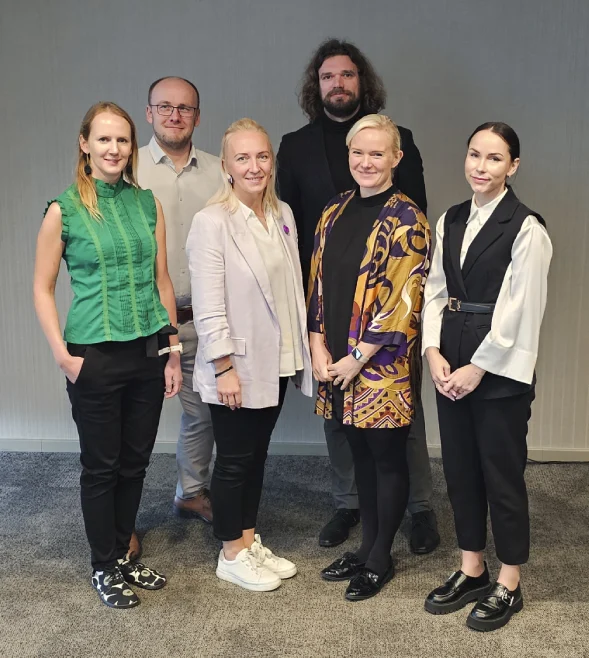-
Other audit services
We help clients with the application and use of foreign financial aid of EU and other funds and help prepare financial reports.
-
Audit calculator
The calculator will answer if the company's sales revenue, assets or number of employees exceed the limit of an inspection or audit.
-
Payroll and related services
We perform payroll accounting for companies whether they employ a few or hundreds of employees.
-
Tax accounting
Grant Thornton Baltic's experienced tax specialists support accountants and offer reasonable and practical solutions.
-
Reporting
We prepare annual reports in a timely manner. We help to prepare management reports and various mandatory reports.
-
Consolidation of financial statements
Our experienced accountants and advisors help you prepare consolidation tables and make the consolidation process more efficient.
-
Consultancy and temporary staff
Our experienced specialists advise on more complex accounting transactions, rectify poor historic accounting, and offer the temporary replacement of an accountant.
-
Outsourced CFO service
Our CFO service is suitable for companies of all sizes and in all industries. We offer services to our clients in the required amount and competences.
-
Assessment of accounting processes
We help companies to implement accounting practices that are in compliance with local and international standards.
-
Accounting services for small businesses
We offer affordable service for small businesses. We help organize processes as smartly and cost-effectively as possible.
-
Cryptocurrency accounting
We keep up with blockchain technology to serve and advise crypto companies. We are supported by a network of colleagues in 130 countries.
-
Trainings and seminars
Our accountants have experience in all matters related to accounting and reporting. We offer our clients professional training according to their needs.

-
Business advisory
We offer legal support to both start-ups and expanding companies, making sure that all legal steps are well thought out in detail.
-
Fintech advisory
Our specialists advise payment institutions, virtual currency service providers and financial institutions.
-
Corporate advisory
We advise on legal, tax and financial matters necessary for better management of the company's legal or organizational structure.
-
Transaction advisory
We provide advice in all aspects of the transaction process.
-
Legal due diligence
We thoroughly analyze the internal documents, legal relations, and business compliance of the company to be merged or acquired.
-
In-house lawyer service
The service is intended for entrepreneurs who are looking for a reliable partner to solve the company's day-to-day legal issues.
-
The contact person service
We offer a contact person service to Estonian companies with a board located abroad.
-
Training
We organize both public trainings and tailor made trainings ordered by clients on current legal and tax issues.
-
Whistleblower channel
At Grant Thornton Baltic, we believe that a well-designed and effective reporting channel is an efficient way of achieving trustworthiness.

-
Business model or strategy renewal
In order to be successful, every company, regardless of the size of the organization, must have a clear strategy, ie know where the whole team is heading.
-
Marketing and brand strategy; creation and updating of the client management system
We support you in updating your marketing and brand strategy and customer management system, so that you can adapt in this time of rapid changes.
-
Coaching and development support
A good organizational culture is like a trump card for a company. We guide you how to collect trump cards!
-
Digital services
Today, the question is not whether to digitize, but how to do it. We help you develop and implement smart digital solutions.
-
Sales organisation development
Our mission is to improve our customers' business results by choosing the right focuses and providing a clear and systematic path to a solution.
-
Business plan development
A good business plan is a guide and management tool for an entrepreneur, a source of information for financial institutions and potential investors to make financial decisions.
-
Due diligence
We perform due diligence so that investors can get a thorough overview of the company before the planned purchase transaction.
-
Mergers and acquisitions
We provide advice in all aspects of the transaction process.
-
Valuation services
We estimate the company's market value, asset value and other asset groups based on internationally accepted methodology.
-
Forensic expert services
Our experienced, nationally recognized forensic experts provide assessments in the economic and financial field.
-
Business plans and financial forecasts
The lack of planning and control of cash resources is the reason often given for the failure of many businesses. We help you prepare proper forecasts to reduce business risks.
-
Outsourced CFO service
Our CFO service is suitable for companies of all sizes and in all industries. We offer services to our clients in the required amount and competences.
-
Reorganization
Our experienced reorganizers offer ways to overcome the company's economic difficulties and restore liquidity in order to manage sustainably in the future.
-
Restructuring and reorganisation
We offer individual complete solutions for reorganizing the structure of companies.
-
Corporate taxation
We advise on all matters related to corporate taxation.
-
Value added tax and other indirect taxes
We have extensive knowledge in the field of VAT, excise duties and customs, both on the national and international level.
-
International taxation
We advise on foreign tax systems and international tax regulations, including the requirements of cross-border reporting.
-
Transfer pricing
We help plan and document all aspects of a company's transfer pricing strategy.
-
Taxation of transactions
We plan the tax consequences of a company's acquisition, transfer, refinancing, restructuring, and listing of bonds or shares.
-
Taxation of employees in cross-border operations
An employee of an Estonian company abroad and an employee of a foreign company in Estonia - we advise on tax rules.
-
Tax risk audit
We perform a risk audit that helps diagnose and limit tax risks and optimize tax obligations.
-
Representing the client in Tax Board
We prevent tax problems and ensure smooth communication with the Tax and Customs Board.
-
Taxation of private individuals
We advise individuals on personal income taxation issues and, represent the client in communication with the Tax and Customs Board.
-
Pan-Baltic tax system comparison
Our tax specialists have prepared a comparison of the tax systems of the Baltic countries regarding the taxation of companies and individuals.
-
Recruitment services – personnel search
We help fill positions in your company with competent and dedicated employees who help realize the company's strategic goals.
-
Recruitment support services
Support services help to determine whether the candidates match the company's expectations. The most used support services are candidate testing and evaluation.
-
Implementation of human resource management processes
We either assume a full control of the launch of processes related to HR management, or we are a supportive advisory partner for the HR manager.
-
Audit of HR management processes
We map the HR management processes and provide an overview of how to assess the health of the organization from the HR management perspective.
-
HR Documentation and Operating Model Advisory Services work
We support companies in setting up HR documentation and operational processes with a necessary quality.
-
Employee Surveys
We help to carry out goal-oriented and high-quality employee surveys. We analyse the results, make reports, and draw conclusions.
-
HR Management outsourcing
We offer both temporary and permanent/long-term HR manager services to companies.

-
Internal audit
We assist you in performing the internal audit function, performing internal audits and advisory work, evaluating governance, and conducting training.
-
Internal Audit in the Financial Services Sector
We provide internal audit services to financial sector companies. We can support the creation of an internal audit function already when applying for a sectoral activity license.
-
Audit of projects
We conduct audits of projects that have received European Union funds, state aid, foreign aid, or other grants.
-
Prevention of money laundering
We help to prepare a money laundering risk assessment and efficient anti-money laundering procedures, conduct internal audits and training.
-
Risk assessment and risk management
We advise you on conducting a risk assessment and setting up a risk management system.
-
Custom tasks
At the request of the client, we perform audits, inspections and analyzes with a specific purpose and scope.
-
External Quality Assessment of the Internal Audit Activity
We conduct an external evaluation of the quality of the internal audit or provide independent assurance on the self-assessment.
-
Whistleblowing and reporting misconduct
We can help build the whistleblowing system, from implementation, internal repairs and staff training to the creation of a reporting channel and case management.
-
Sustainability advisory
We help solve issues related to the environment, social capital, employees, business model and good management practices.
-
Sustainability audit
Our auditors review and certify sustainability reports in accordance with international standards.
-
Sustainable finance
We help investors to analyze the environmental issues, social responsibility and good management practices of the company of interest.
-
Sustainable tax
Our international tax specialists define the concept of sustainable tax behavior and provide services related to sustainable tax behavior.
-
Digital strategy
We help assess the digital maturity of your organization, create a strategy that matches your needs and capabilities, and develop key metrics.
-
Intelligent automation
We aid you in determining your business’ needs and opportunities, as well as model the business processes to provide the best user experience and efficiency.
-
Business Intelligence
Our team of experienced business analysts will help you get a grip on your data by mapping and structuring all the data available.
-
Cybersecurity
A proactive cyber strategy delivers you peace of mind, allowing you to focus on realising your company’s growth potential.
-
Innovation as a Service
On average, one in four projects fails and one in two needs changes. We help manage the innovation of your company's digital solutions!


The audit requirement recently applied to crypto companies will notably increase the workload of auditors who are expected to provide a service that is largely lacking in Estonia.
As of 15 June, the 300 companies operating under a crypto licence in Estonia must engage an auditor. “This means 300 new customers for us. This will obviously lead to a small market failure, because auditors are receiving significantly more inquiries than usual and this is a problem,” said Mart Nõmper, partner and head of audit and assurance services at Grant Thornton Baltic, on the Äripäev radio show On a Growth Trajectory.
Nõmper added that auditing crypto companies requires significant specialist knowledge and when there is no time to adjust, problems arise. “Auditors are conservative people and must ensure that they have the necessary competencies and knowledge before taking on new cases,” Nõmper explained. “The crypto company auditing service is not currently provided in Estonia. However, the involvement of an expert from abroad is very expensive and Estonian virtual service providers are not willing to pay for it.” Nõmper also noted that demand has risen in Estonia, but there is currently no supply.
Specific skills are required
The lack of supply is due to both the sudden audit requirement for virtual currency service providers and the lack of specific skills. Märt-Martin Arengu, head of the Estonian Auditors’ Association, said that in many ways auditors have to deal with blockchain technology itself – they need to audit where the data is entered, where the customer data is stored and whether all transactions are recorded. These are specialist skills that are not normally required of an auditor.
According to Arengu, an auditor is not expected to be an expert on all aspects, and the problem could be solved if it were possible to involve external experts. “In addition, we are trying to call on the representatives of the crypto industry to adapt a framework from outside Estonia within a few months,” he added.
Change means wage pressures
Auditing virtual currency service providers is also a new business opportunity in this market. “The salaries, workload and cost of auditors will likely increase in the near future,” Nõmper said. “There is also a growing number of companies that are passing the limit that requires them to complete a statutory audit.”
Currently, the average gross salary in audit firms is 2,120 euros, but in reality, it is more, according to Nõmper. “Statistics only take into account smaller companies, the owners of which pay more dividends than average and whose salary level is therefore artificially low,” Nõmper explained.
Increasing competition for labour is also forcing the salaries of auditors to rise. The Estonian Auditors’ Association has 500 members, of whom 350 are auditors and the remainder are audit firms, and there are 9,000 companies that require auditing services. “They cover 85 percent of the Estonian economy,” said Arengu.
At the same time, the audit industry needs to compete for professionals in both the financial and IT sectors. “The IT sector has the ability to offer much higher salaries, so the attractiveness of auditing needs to be increased,” said Arengu.
The digitalisation of both the auditing and accounting sectors could be enhanced in the future. It is currently being pushed forward, principally in regard to accountancy services. According to Tammeraja, a network between the information systems of companies is already being established. “Instead of e-mail, it is planned that important documents, including invoices, will flow through this new business-to-business network,” he explained.
Auditors have oversight, accountants less so
According to Märt-Martin Arengu, head of the Estonian Auditors’ Association, the quality level of auditors is indicated by the annual quality label, with the green label being awarded to 80 percent of the auditors operating in the market.
The quality of an auditor is assessed, among other things, by the client who chooses the auditor or accountant.
The accounting sector has to date been unregulated, but here too there are indicators regarding the quality of the service. For example, the Estonian Auditors’ Association annually compiles the Estonian Accounting Confidence Index. This is based on the so-called pure estimates of the accounts prepared by the accountants.
According to Arengu, the most common errors of accountants are related to the non-impairment of receivables, incorrect or non-execution of inventories or non-assessment of stock.
Another theme for the future: sustainability reporting
Head of the Estonian Auditors’ Association Märt-Martin Arengu said that another future trend is sustainability reporting. “This is a new type of reporting, the compiling and examination of which must be taken into account,” the expert said, noting that future reports will also reflect different principles of sustainability. Thorough monitoring is expected in the addressing and examination of the latter, as well as in general reporting
If you have similar challenges and questions, please contact our specialists.





